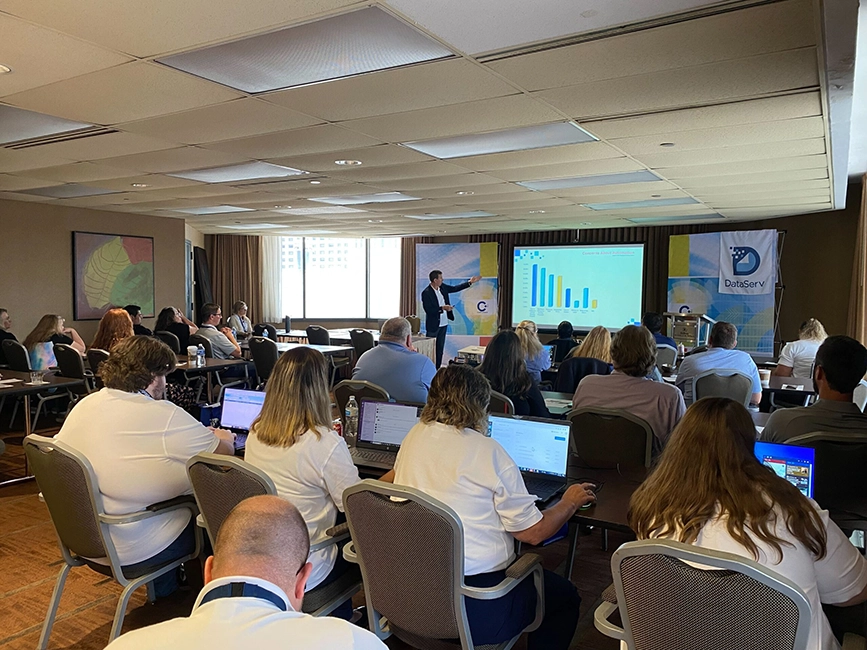AP Automation Frequently Asked Questions
What is AP Automation?
AP automation is the use of software systems to automate and streamline the accounts payable processes. An AP automation solution maximizes efficiency while minimizing the potential for mistakes common in antiquated, manual systems. Advanced AP automation systems, like those offered by DataServ, offer added features such as document retention and destruction, analytics and dashboards, and integrated mobile capabilities.
Why is AP automation important?
There are many reasons why automating accounts payable automation is important for businesses. Perhaps the most obvious reason is that it can save the business time and money. With accounts payable automation solutions, companies can reduce or eliminate manual tasks associated with processing invoices, such as data entry, matching invoices to purchase orders, and approvals. This can free up time for employees to perform other tasks that contribute to the business, such as generating revenue.
AP automation can also help businesses improve their relationships with suppliers. When invoices are processed quickly and accurately, suppliers are paid on time, and they are more likely to offer favorable terms, such as discounts, to businesses that pay promptly. In addition, AP automation can help companies manage their cash flow more effectively. Businesses can better plan their cash outflows and avoid costly interest charges by clearly understanding what is owed to suppliers and when payments are due.
Overall, automating accounts payable can provide many benefits to businesses. It can save time and money, improve supplier relationships, and help businesses manage their cash flow. If you are considering automating your AP process, be sure to weigh the costs and benefits to ensure it is the right decision for your business.
Why do companies invest in AP automation?
Companies can save time and money, enhance financial controls, gain better visibility into financial obligations, and drive continuous improvements over time through effective business intelligence. Substantial ROI potential almost always exists for most, and it also provides a better employee and supplier experience than those without accounts payable invoice automation. AP automation has become a must-have to compete in most industries today.
What are the benefits of accounts payable automation solutions?
Sticking true to the old “time is money” adage, the two biggest attractions to AP automation go hand in hand: time savings and money savings. By automating your accounts payable processes and procedures, you’re saving your business valuable clerical hours and virtually eliminating the potential for errors. AP automation streamlines business processes top to bottom and can vastly improve your company’s productivity and potential for growth. Without the burden of constant manual processing and filing tasks, your staff can focus their time, energy, and talents on building the future of your business.
But, maybe more importantly then ever – automation impacts the satisfaction of your AP team. In fact, most new AP Processor do not want to work at a company without automation in place. Humans need to work with thier brains not their fingers in a modern AP department.
How much money does AP automation save?
An effective and efficient accounts payable invoice automation system can be a game-changer for your business. However, breaking your cost savings down to a concrete and specific dollar amount is dependent on a wide variety of variables. We can say that the right single-stream invoicing software system can reduce manual filing and processing times by up to 80 percent. AP automation solutions reduce invoice processing costs and dramatically improve payment accuracy. If you are growing and can expand your AP volume without adding staff, you will see substantial returns. That equates to less time rustling papers and more time focused on value-added tasks necessary to improve customer relations and grow your business.
What is an AP system?
Some vendors confuse an AP system or module (typically of an ERP system) with AP Invoice Automation. An accounts payable automation solutions system should be an Exceptions-based, Pre-ERP system that intelligently automated and eased the process of receiving, routing, coding, and approving company invoices for payment. It should eliminate as many “touches” as possible while freeing up time for your people to focus on driving continuous improvements that contribute to your bottom line. The best of them, like DataServ, will focus on automating all that can be automated while easing the process of working the “exceptions” to achieve the accurate, timely processing of invoices approved for payment within your established cash management policies.
What is the AP automation process?
The AP automation process begins with a comprehensive understanding of the current AP processes. This includes all the people involved, processes currently followed, and technologies now used.
Armed with this understanding, DataServ can guide clients to the best AP Automation solution for their needs today and into the future. This can and should be an “evolutionary” process” vs. a “revolutionary process,” depending on one’s current state of readiness to adopt automation and ability to drive the change necessary.
We have found that an evolutionary approach like this works while taking the “big bang” approach of trying to bite it all off at one time can add risk. Once you are ready, the primary components that comprise a holistic AP automation solution include:
- Invoice Processing Machine – Takes in your invoices regardless of form or format (I.e., Paper, Email, EDI, Other, etc.) to capture and normalize key invoice data into a single, standardized stream of data used for automation downstream, as well as, creates a digital image of the invoice to see in the system.
- Automated Workflows – Establishes pre-ERP, automated workflows to properly route, code, and approve all Non-P.O. based transactions for payment. Also, automatically route all exceptions to the best person who can correct them and keep the invoice process flowing.
- AutoVouch™ – Establishes a pre-ERP, fully touchless process to intelligently perform a two or 3-way match of P.O.-based invoices against corresponding P.O. data & Receipt data files integrated into the system. Also, establish exception workflows for any that do not successfully match to be worked by the appropriate parties.
- ERP Interface – integrate your General Ledger (GL) Account structure, Vendor Master Data, Chart of Accounts, P.O. Master and Open P.O Data, Receiving Data, and Payment Validation Files daily with the AP Automation system in the safest and most secure method possible. (Hint: this is why we have successfully followed our “lowest common denominator” approach to integrations for 25+ years!).
- Analytics – establish the right mix of analytics reporting to help drive the continuous improvements that are always possible with access to better intelligence.
What is OCR/ICR?
OCR, or Optical Character Recognition, more recently known as Intelligent Character Recognition (ICR) is a technology that extracts usable data from static document images such as PDF’s, Emails, etc. and turns them into editable data. This allows users throughout your organization to access editable documents simply by typing in a name, purchase order, item number, or any other key piece of information. DataServ invented the worlds first SaaS OCR and continues to evolve with input from 100’s of millions of documents to transform our client’s AP from manual to digital. OCR is the key technology that facilitates digital transformation at the entry point for AP.
What is automated 3-Way matching?
Matching (aka Vouching) is the most famous of all the Financial Controls and as such is really the cornerstone of accounting in practice. Two way matching links your Purchase Order with the vendor invoice. Three way matching adds the preferred, tighter control of Receiving information.
When done manually, the labor-intensive process can be daunting and add-up to many AP manhours. Automated matching software, like DataServ’s AutoVouch™ system, employ Artificial Intelligence to can knock out the time-consuming process in a fraction of the time and with superior accuracy.
Any system you look at should also provide a process by which to handle the exceptions that occur within matching.
How can AP automation improve efficiency?
Automating accounts payable processes improves efficiency by allowing your team to eliminate the time-consuming, and potentially error-prone manual processing tasks necessary such as email sorting, manual routing, data entry, and matching. By digitizing AP documents, and streamlining workflow, you’re freeing your team from these menial administrative tasks and allowing them to focus their energy on steps to grow and improve your company.
How do I streamline an AP approval process?
It takes more than software!
It takes a partnership, preferably with a team that has a lot of experience. AP is a specialized, complex business process that impacts a lot of various departments at you organization. Seek out a provider that can bring Best Practices, analysis skills and Change Management tools to the project.
Begin with an assessment of your current process and a list of goals for process improvement. The APA software on the market today is primarily SaaS – which means you will need less IT assistance. But you will need a team that understands you process but can see a vision for the future. Much of AP is the same from company to company – so look for a Provider who can deliver a standard process that meets your needs and then adapt to your unique circumstance.
What is automated workflow?
A workflow is the sequence of administrative processes that a project or piece of work must pass between initiation to completion. More often than not, this involves touches by several members and/or departments throughout your organization, and if not done efficiently and effectively, items can be overlooked and mistakes can be made. Automated workflow, by contrast, takes these processes and streamlines them digitally. DataServ SaaS workflow is designed to automate routing, approvals, work queues, notices, and more in a constant effort at keeping all key players on the same page and working toward the same goal. Doing so dramatically improves productivity while cutting costs and minimizing the potential for error.
How do we manage paper invoices?
As much as we aim to make business AP processes completely paperless, sometimes you’re bound to have a client that insists on doing things the old-fashioned way. That’s where our Invoice Processing Machine comes into play. We receive invoices on your behalf in any format, via any source, even paper. Within a very quick turnaround time, those paper invoices have been digitized through our SaaS-based OCR, undergone a 5-step verification process, and been made available for you in DataServ. We then retain or destroy documents based on industry rules and regulations and your company’s needs.
What is touchless invoice processing?
Touchless invoice processing refers to systems that can actually eliminate human effort and manual work within the AP process. The DataServ AutoVouch™ system, for example utilizes Artificial Intelligence to “work like a human” and perform a two or three-way, or four-way match. Transactions that successfully match within tolerances automatically flow into your business’s ERP system to be scheduled for payment without being “touched” by an AP Processor.
What is the ROI with an accounts payable automation solution?
Obviously there are a number of variables that can affect your AP automation ROI: the size of your business, the cost of your labor, the price point of your goods and services, and so on and so forth. In general, however, DataServ clients routinely see a per-invoice return on investment of between five and fifteen dollars. Try our ROI Estimator to calculate your potential return on investment.
Can AP automation software integrate with ERP systems?
APA should not replace or alter your system of record. There are many common data elements used by both systems. The most popular data interface method used in the industry over the last 25 years has been a simple batch, flat file (.CSV) interchange scheduled via sFTP. Due to its consistency and reliability, this method has successfully supported thousands of solutions around the world.
What are common features of AP automation software?
Accounts payable automation software comes in all shapes and sizes, and it’s important to make sure that the provider you choose for your business is able to meet every one of your AP automation needs. Here are the most desired features we come across in client discovery calls:
- Digitize data at 99%+ accuracy
- Support for multiple PO types
- PO matching with AutoVouch™
- Touchless non-PO automated approval routing and coding
- Route data to ANY ERP
- Tailored dashboards & analytics
- Workflows tailored to a business’s unique needs
- Centralized processing for multiple locations
How do you measure accounts payable performance?
Measuring performance as it relates to accounts payable comes down to analyzing the time and resources necessary to complete a single invoice. For instance, what is your cost per processed invoice? What is the average time per processed invoice? How many invoices are processed per employee per day? In taking the time to break down each of these figures, you’ll find that accounts payable automation may very well be a worthwhile investment and pay for itself in no time. DataServ makes this easy with our built-in analytics and dashboards.
What is paperless document management?
Paperless document management is a system in which hard copy files and documents are migrated to a digital format. A concept adopted by more and more businesses each year, paperless document management is the eco-friendly solution for boosting efficiencies, improving accuracy, and cutting costs associated with supplies and administrative labor. DataServ’s AutoVouch™, for example, transforms complicated and mistake-prone paper systems into a seamless transactional process that virtually eliminates the potential for human error. AutoVouch uses SaaS OCR technology to migrate paper documents into convenient digital formats to ensure maximum efficiency and accuracy at all times.
Let’s Start a Conversation
Regardless of where you are at in your AP automation journey, DataServ will meet you there and help you evolve.


























